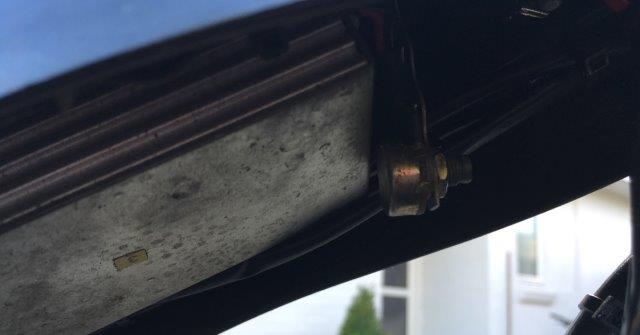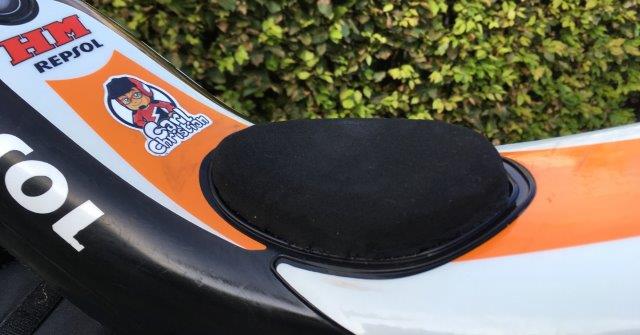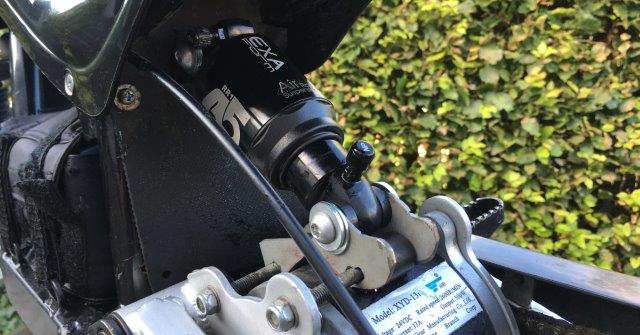If your child starts early, there is a good chance that they are starting on a 12.5″ machine. There are no big differences between small machines, especially if you are starting with a slightly older (used) machine. We have some experience with upgrading 12.5″ machines. The upgrades have worked for us, and you can evaluate whether any of these are suitable for you.
Please note that some of these upgrades can void the warranty!
We are using an OSET 12.5 from 2012 as basis, as this was the machine started on. A great little machine, as most people know, since it is one of the more common machines.
Moving the potentiometer and stop/start
These early OSET models (in my opinion) are affected by a small design error. The potentiometer to adjust the top speed of the motorcycle must be adjusted with a small screwdriver in a hole at the back of the battery box. Surely the idea was to make this feature inaccessible to the child. The challenge is, however, that it is also very difficult to adjust for others. The problem being, that most of us need to adjust the top speed several times during training.
Therefore, it is an easy little modification to move the potentiometer to a more accessible location. We chose to put it under the “tank”, where it could be adjusted with 2 fingers. This way, it was still inaccessible to the rider.

In the same way, we have chosen to move the startup button up to the steering, instead of using the key solution that came with the machine – but this is obviously up to your preference.
Alternatively, of course, you could use a magnet lock, as supplied with newer machines.
Replacement of rear damper
The rear dampers on these small 12.5″ machines leave a lot to be desired. It is debatable if you can defined it as a damper since it is just a spring suspension. The original actually works okay if the child is standing. When the child stands up, the child’s own legs will take care of quite a bit of the damping, and especially rebound damping.
However, most people will find that the child does not stand up. The ride can be a bit rough for the child, as the spring strikes back hard when the child rides over uneven ground. Of course, this can be adjusted slightly in the tension of the spring (how hard you tighten the spring).
Our solution to this problem was to find an air damper of the kind you know from bikes and larger electric motorbikes. The challenge was to find a damper that is short enough to fit. On an OSET 12.5 2012, the damper is 100mm measured from bolt hole to bolt hole. The smallest we could find was 125mm, which meant that new fittings had to be made. This is easily done, with a few pieces of flat iron, spacers and some threaded rods.
The difference is significant, making the motorcycle much gentler on the rider, especially when he or she rides sitting down.
Remember that an air damper must have two air chambers. One chamber for damping and one chamber for rebound damping.
Use of gas assist
When you are not very big, you get tired quickly – especially in the hand that controls the throttle. Therefore, you may want to install gas assist. You can find the juniormoto.com article about gas assist here.
Seat
Most riders want to sit down – at least some of the time – especially if you are the size to fit a 12.5″ machine. However, the guard can be quite slippery, causing the rider to slide around the motorcycle. Combined with the original rear damper, this could make for a rough ride. We ended up installing a piece of racer seat foam to make a small seat. Racer seat foam is known from road racing and is a cheap alternative to a seat. It can be cut and sanded precisely the shape you want and then glued to the plastic.
Of course, there are also real seat solutions from most manufacturers. Common to these, however, is that they increase seat height.

None of the above modifications are necessary for the child to enjoy his or her motorcycle. They should be seen as the options for optimizing an already outstanding product.




 Using a communication system for training
Using a communication system for training
